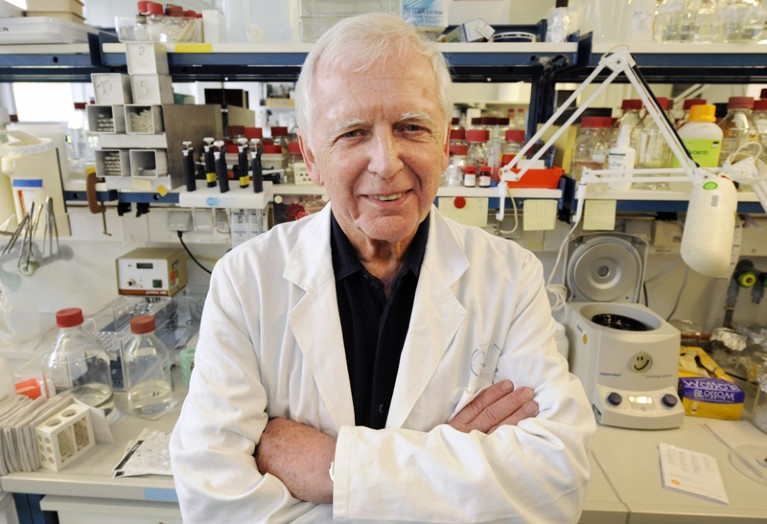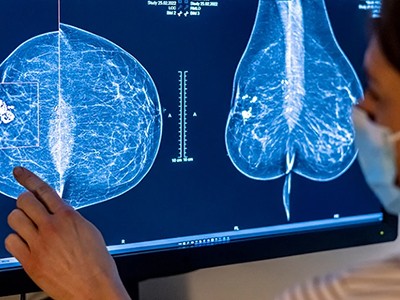
Credit: Thomas Lohnes/DDP/AFP via Getty
German virologist Harald zur Hausen proved that human papillomaviruses (HPVs) can cause cervical cancer. He laid the foundations for the development of a vaccine that now benefits millions of people around the world, and opened up a new dimension of cancer prevention. In 2008, zur Hausen was awarded the Nobel Prize in Physiology or Medicine for his achievements. He has died at the age of 87.
About 700,000 HPV-associated cancers occur each year worldwide. Thanks to zur Hausen’s research, a vaccine to prevent them has been available since 2006. More than 100 countries now include HPV vaccination in their immunization programmes, as recommended by the World Health Organization in pursuit of its goal of eradicating cervical cancer worldwide.
From 1983 to 2003, zur Hausen also steered and established the international reputation of the German Cancer Research Center (DKFZ) in Heidelberg. As its chair and scientific director, he implemented a policy of stringent international benchmarking and peer review, recruited outstanding scientists from all over the world and set up units that linked the DKFZ to the clinic.
Huge leap in breast cancer survival rat
Born in Gelsenkirchen in the state of North Rhine-Westphalia in Germany, zur Hausen knew he wanted to be a natural scientist from a young age. He loved biology at school, although the first years of his life were overshadowed by the Second World War: his elementary school was closed in 1943, one year after he began to attend it.
After graduating from secondary school, zur Hausen studied medicine and biology at the University of Bonn. He completed his medical studies at the University of Hamburg and the Medical Academy in Düsseldorf, where he finished his MD thesis and medical degree in 1960. He qualified as a physician in 1962. In Düsseldorf, he learnt the techniques necessary to study chromosomes and evaluate how viruses modify their structure.
His studies from 1966 to 1969 at the Children’s Hospital of Philadelphia, Pennsylvania, were decisive for his career. He joined a group of researchers who later proved a connection between Epstein–Barr virus (EBV) and Burkitt’s lymphoma, by showing that EBV particles were present in lymphoma cells. He also found that another type of virus (adenovirus type 12) caused damage to chromosomes in human embryonic kidney cells.
In 1969, zur Hausen moved to Julius Maximilian University in Würzburg to join its newly opened virology institute. There he built his own research group. He and his colleagues were able to detect the genomes of EBV in Burkitt’s lymphoma and nasopharyngeal cancer cells, although these cells did not produce progeny virus. This was the first experimental proof for the presence of latent EBV infections in human cancer cells.
On learning that some benign genital warts could become cancerous, zur Hausen wondered whether the infectious agents causing them might also trigger the development of certain tumours. In 1972, when he became chair of a new clinical virology institute at the University of Erlangen–Nuremberg in Germany, he began investigating the role of HPVs in the development of cervical cancer. At the time, most scientists in the field suspected herpesviruses as the trigger, on the basis of studies screening blood for past exposure to infection. However, zur Hausen’s group failed to detect herpesvirus genomes in cervical lesions. Instead, they found hints of HPV-related genome sequences. His later work focused on isolating and characterizing HPVs from other types of wart.
Almost half of cancer deaths are preventable
After his move to the University of Freiburg in 1977, zur Hausen and his colleagues isolated several more types of HPV in juvenile laryngeal papillomas and cervical cancers. In the early 1980s, the team identified two HPVs that contribute to about 70% of cervical tumours.
In subsequent experiments, the zur Hausen group showed that HPV-genome fragments that encompass two genes, E6 and E7, are regularly retained and expressed in cervical cancer cells, that these genes can transform normal human cells and that inhibiting the expression of these genes arrests the growth of the cancer cells. Currently, there are about 230 known and characterized types of HPV, 14 of which can cause vulvar, vaginal, penile, anal and oropharyngeal tumours as well as cervical cancer.
Zur Hausen devoted himself to research until the end, investigating infectious causes of malignant tumours. Since 2001, his focus has been on ‘bovine meat and milk factors’ — small, ring-shaped DNA molecules found in bovine sera and cow’s milk products, which are associated with colorectal and other cancers.
The daily question to his team members “What’s new?” was a hallmark of Harald’s visits to his laboratory. He cultured an inspiring and creative working atmosphere in which everyone felt comfortable and could deliver top-notch performance. He was a visionary who doggedly pursued his ideas and questioned everything critically and constructively. The high standards he set for himself he also inspired in others, and he always treated his counterparts with the highest esteem. His wife and colleague, the biologist Ethel-Michele de Villiers, was a strong influence who helped to ensure that Harald will be remembered as a person who rendered oUtstanding contributions to humankind.

 COVID-19 digital contact tracing worked — heed the lessons for future pandemics
COVID-19 digital contact tracing worked — heed the lessons for future pandemics
 Huge leap in breast cancer survival rat
Huge leap in breast cancer survival rat
 Almost half of cancer deaths are preventable
Almost half of cancer deaths are preventable
 How the Y chromosome makes some cancers more deadly for men
How the Y chromosome makes some cancers more deadly for men
 Women’s health research lacks funding — these charts show how
Women’s health research lacks funding — these charts show how








